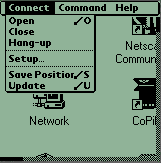Let me just tell you that this is just about the neatest thing since sliced bread. It's a simple thing, and of course I shouldn't be amazed that it's possible. But as an old-school computing guy, I'm continually amazed at what I can do with a device that fits in my pocket.
Before I tell you about
PalmVNC, let's talk about some background information.
VNC stands for Virtual Network Computing. It is a remote display system which allows you to view a computing 'desktop' environment not only on the machine where it is running, but from anywhere on the Internet and from a wide variety of machine architectures.
Some people say it's like XWindows, sometimes they say it's like PCAnywhere. It's kind of like both. But it's different. You can get the Source Code for it. (which means, you can improve it if you're a
bit head!)
Some of the things that make it different are:
 No state is stored at the viewer. This means you can leave your desk, go to another machine, whether next door or several hundred miles away, reconnect to your desktop from there and finish the sentence you were typing.
No state is stored at the viewer. This means you can leave your desk, go to another machine, whether next door or several hundred miles away, reconnect to your desktop from there and finish the sentence you were typing. - It is small and simple. The Win32 viewer is about 150K in size and can be run directly from a floppy. There is no installation needed.
- It is truly platform-independent. A desktop running on a Linux machine may be displayed on a PC. Or a Solaris machine. Or any number of other architectures. The simplicity of the protocol makes it easy to port to new platforms. (LIKE PALMOS!) There are literally DOZENS of Platforms supported by VNC.
- It is free!
VNC was created by ORL, the Olivetti Research Laboratory. In January 1999, AT&T acquired ORL to create AT&T Laboratories Cambridge.
Many people have contributed to the VNC
project, since the source code was released to the public. A Palm version was originally developed by Vladimir Minenko, a research scientist with the International Computer Science Institute (ICSI), University of California at Berkeley.
His work was then continue by the folks at Harakan
Software. This is the version we are talking about today, and this is the one that you should be VERY interested in checking out.
They added new features to PalmVNC like:
- Ultra-thin client uses less than 40Kb of Palm memory
- Color on Palm IIIc devices
- 4- or 16-shade greyscale on other devices
- Supports server-side scaling to reduce bandwidth
- Can be stored in Flash memory
Requirements >>